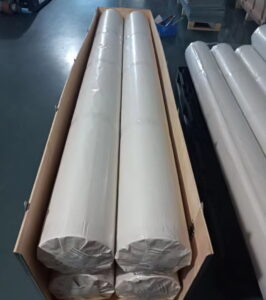When storing EVA film for laminated glass, there are several key considerations to ensure the film retains its quality and can be used effectively when needed.
Moisture Sensitivity: EVA films are moisture sensitive when not laminated yet. Therefore, they should be stored in moisture-tight, aluminum-lined packaging or opaque polyethylene bags. The temperature of the storage room should be kept below 35°C to avoid roll blocking. However, it is not necessary to store the rolls in a refrigerated warehouse as in the case of PVB. If the temperature cannot be controlled below 35°C (e.g., in warm or tropical regions), it is advised to order EVA with a thin interleave foil. Shelf Life: EVA foil manufacturers generally advise a shelf life of 9 months to a maximum of one year. The presence of the adhesion promoter and cross-linking system in EVA can deteriorate quickly in the unprocessed foil over time. Therefore, it’s important to use the EVA within this period. Handling: There are no special requirements necessary for handling EVA in the lamination lay-up room. However, one must avoid that moisture can condensate on the EVA sheet. When EVA material is taken out of the packaging, it should be used immediately and leftover materials should be re-packed after use. EVA should not stay in the open for more than 8 hours. Storage Conditions: The EVA interlayer films should not be piled up more than three layers. The storage period should not exceed 12 months. Avoid sunlights and thermal radiations, and the temperature of the storage environment should be under 45 degrees. Don’t store or transport EVA interlayer film with combustible or explosive materials. Edge Sealing Reagent: Before laminating EVA interlayer film, confirm the corrosive and permeability of the edge sealing reagent or glass glue, as these may lead to EVA interlayer films breaking away from glasses.
By following these guidelines, you can ensure the quality and longevity of your EVA film for laminated glass.
The storage of EVA film for laminated glass.
You are here:
- Home
- Technical News
- The storage of EVA film…
